Menus
- Yamaha two-stroke engines in comparison
- Yamaha RD 350 LC 4L0
- Yamaha TZ 350 G 3G3
- Two-stroke power for the people – RD 350 LC
- From the box to the slopes
- The world champion cylinder
- Cylinder dimensions
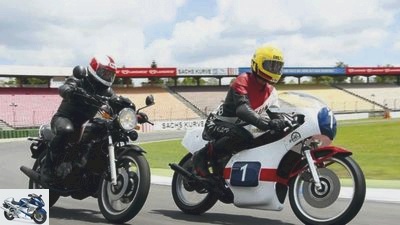
Jahn
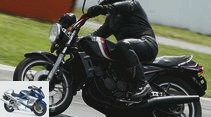
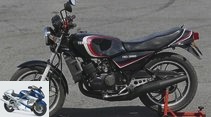
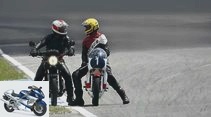
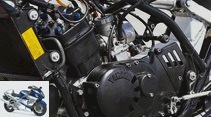
14th photos
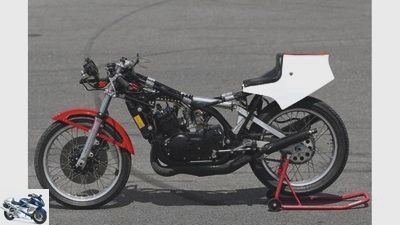
Jahn
1/14
Out of the box so quickly that talented racing drivers could drive onto the podium with a standard TZ 350 G. The last TZ series was stable and mature. Their end was sealed when the 350cc class was deleted from the World Cup calendar in 1983.
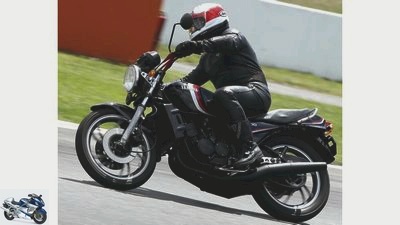
Jahn
2/14
The RD 350 combines impeccable road quality with a touch of racing technology.
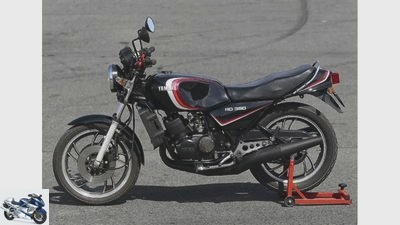
Jahn
3/14
Even if the RD 350 LC was touted by Yamaha as a roadworthy replica of the TZ, the equipment with high handlebars and double seat made it clear that this motorcycle was intended for the road. The softly tuned chassis confirmed this.
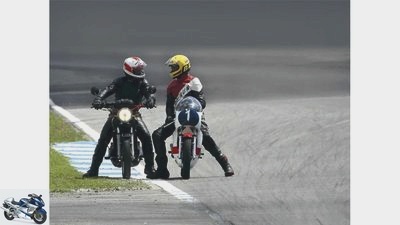
Jahn
4/14
Short race track talk for in between: "And yours is doing so well too?"
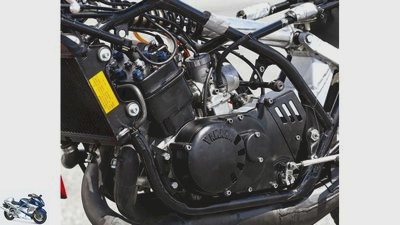
Jahn
5/14
TZ 350 drive with crossed exhaust manifolds and huge 38 power jet carburetors.
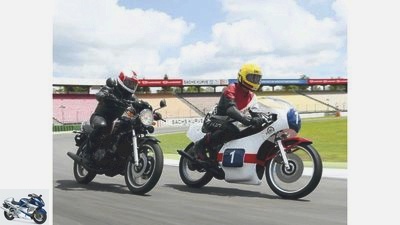
Jahn
6/14
Toni Mang’s 350 Yamaha and its uncovered replica RD 350 LC. Even if the replica was not as convincing as the TZ 350 G, it remains an unmistakable classic.

Jahn
7/14
In terms of power, the TZ 350 G is clearly one step ahead, as the Yamaha RD 350 has been clearly trimmed for comfort on the road.
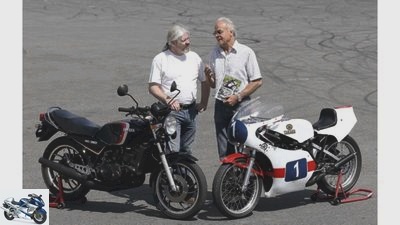
Jahn
8/14
The Grand Prix winner and 350 cm³ German champion Dieter Braun also had the pleasure of driving the Yamaha TZ 350 G on the racetrack.
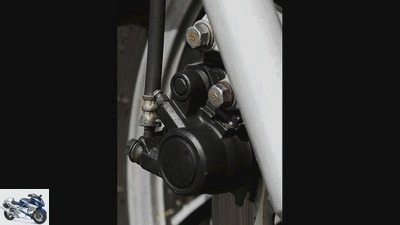
Jahn
9/14
Heavy floating saddle clamps on the RD.
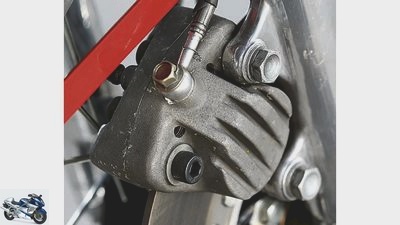
Jahn
10/14
Light, not stable TZ aluminum brake caliper.
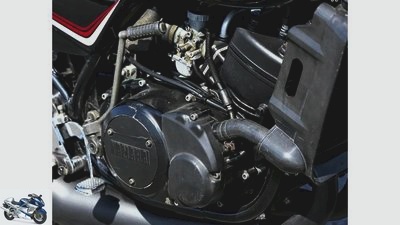
Jahn
11/14
The RD engine’s oil and water pumps are behind plastic.
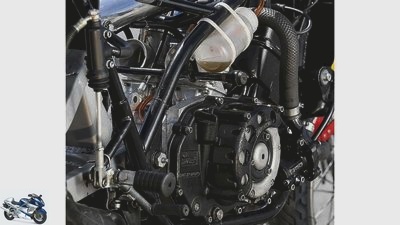
Jahn
12/14
Rattling TZ dry clutch and exposed water pump.
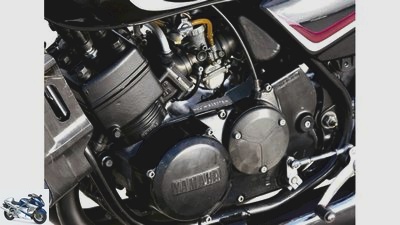
Jahn
13/14
RD 350 engine with diaphragm control and interference pipe between the intake ports.
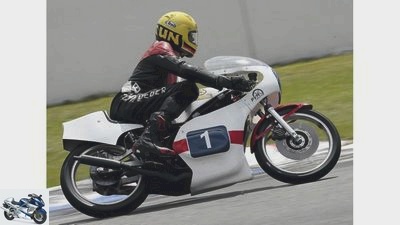
Jahn
14/14
Only real racers will be happy on the TZ 350 – like Dieter Braun.
On the move: Yamaha RD 350 LC and Yamaha TZ 350 G
Yamaha two-stroke engines in comparison
Content of
The hot dream of all two-stroke freaks: a crisp Yamaha TZ 350 with lights, indicators and TÜV stamp. 30 years ago the wish was almost granted. But only almost.
It was the time of the overcrowded starting fields and the German racing elite who were ambitious to the core. Toni Mang fought for the title in the 250cc class and was defeated by a hair’s breadth in the 350cc class by the South African Jon Ekerold. His motorcycle consisted of an Italian Bimota chassis and a Yamaha engine prepared in Germany: the Solo 350 by engine tuner Gunter Seufert.
Others saved costs and effort, took the Production Racer out of the box and won one national race after another. Gustav Reiner, Thomas “Ali” Grassel, Sepp Hage – all on the way from the B license to the world championship, ready to follow in Toni Mang’s footsteps. And all on a motorcycle that dominated the 350 class like no other: the Yamaha TZ 350, the last 3G3 version already out of the box over 70 hp, with 108 kilograms as light as a feather and reliable. Anyone who puzzled out the right carburetor setting from the jungle of main, idle and power jet jets and did not break the cylinders, was well served with it. And fast. So fast that every eager sports driver would spit out of the corner of his mouth when a TZ 350 raced across the racetrack with a shrill whine.
So it was no wonder that the announcement of the water-cooled RD 350 LC got the hobby scene going in 1979. It was hoped that the arduous tinkering and hairdressing had finally come to an end and the new two-stroke engine already had a lot of power in series production. The RD 350 should cost 5034 marks, a real bargain in contrast to the TZ 350 G, which cost 13,500 marks.
Unfortunately, the two-stroke community had to flatten its noses on the shop windows until the summer of 1980. The brisk demand and capacity problems in production massively delayed the start of series production of the RD 350. The test report could only be read in MOTORRAD issue 16/1980. He tore many a racing freak out of his dreams, not only because he criticized the tricky chassis with too slack suspension elements and wear-prone swing arm bearings: “The RD would benefit from tighter damping levels at the expense of comfort, especially since its chassis in long curves tends to be slightly unrest. “
The engine itself was also under fire. Too aggressive in the power development and only after thorough rework by the importer with all the promised 49 hp on the spot, the RD 350 did not meet the high requirements of a real racing replica.
Jahn
The Grand Prix winner and 350 cm³ German champion Dieter Braun also had the pleasure of driving the Yamaha TZ 350 G on the racetrack.
Regardless, Yamaha pepped up the RD 350 LC with racing fairing, hump seat and handlebar stubs to make a cup motorcycle. However, they wanted to give the toxic RD exclusively into the knowledgeable hands of the holder of an A license. Newcomers to the hobby racing scene still had to take a seat on the four-stroke XS 400. The hobbyists and screwdrivers, on the other hand, continued to work with enthusiasm to eradicate the deficiencies and weaknesses of the RD. In a very short time, all kinds of footrest systems, racing fairings and backlash-free swing arm bearings were brought onto the market in order to put the individual dream on the wheels based on the RD 350.
This in and of itself gratifying circumstance made the search for a largely standard RD 350 LC, abbreviation 4L0, very difficult for MOTORRAD CLASSIC. Even in the relevant RD forum (www.rd350lc.de), the editors were mainly offered converted RDs for the photo trips. Reader Ralf Ullrich (www.werbestudio-leimen.de) bailed us out and carted his only slightly modified RD 350 LC into the Hockenheim Motodrom. Why go to Hockenheim? To meet there with ex-world champion Dieter Braun and his sparkling clean TZ 350 G, to celebrate the 30th birthday and to crown this party with a little trip together. Under the slogan “Success from Success”, Yamaha titled the TZ 350 G as the mother of the new RD 350 LC in a double-sided advertisement and described in detail the technical similarities. If you take the basic data to hand, you will actually find many identical points for both classics. In detail, however, it quickly becomes clear that the RD and TZ series are fundamentally different.
Both motors are based on the same housing, but the details differ. In all TZ models, for example, the engine is screwed to the frame in rubber elements at the front, while the RD engines sit rigidly in the frame. This was the only way to reduce the sometimes rough vibrations of the TZ racing engines, which rotate up to 13,000 rpm, to a tolerable level. In order to create sufficient overall width, the TZ cylinders were made in one piece, which allowed a narrow separating web between the overflow ducts and thus a sufficiently large duct cross-section. In the case of the nominally 49 hp RD models of the first series (4L0), on the other hand, two individual cylinders with four steel bolts each were clamped onto the housing, the cylinder cover consisted of one piece. The channel cross-sections of the four main overflow channels are correspondingly small. The fifth straightening channel attached at an acute angle from the inlet does not help much (see cylinder development). The most striking difference: The membrane control of the RD models, which Yamaha promised a smoother power delivery and a more solid torque curve. Yamaha accepted the disadvantage that the small four-reed reed valve block causes a large flow resistance, which massively limits the ease of turning and maximum performance. The RD’s 28-millimeter carburetor alone is only half as large as the 11.34 cm² of the TZ’s 38 power jet carburettors, with a free cross-section of 6.15 cm² (without taking into account the nozzle and needle).
Jahn
The RD 350 combines impeccable road quality with a touch of racing technology.
With a total of six transfer channels and marginally large inlet and outlet slots, an almost optimal gas exchange and full cylinder filling were possible with the standard TZ 350. An increase in performance without a loss of stability was hardly possible with the standard cylinders. For this reason, two-stroke guru Gunter Seufert from the small engine manufacturer Solo in Sindelfingen came up with a cylinder with welded-in bars, which minimized piston tilting and shifted the power to well over 80 hp.
After all, the exhaust system of the RD 350 sets performance limits. Equipped with proper soundproofing for road use and limited in size by the necessary lean angle, even the experienced Yamaha technicians did not achieve optimal resonance oscillation, which significantly influences power and torque in the two-stroke engine. This is different with the TZ 350 exhaust system, which thanks to the crossed exhaust manifold enables a full diameter of the pears, sufficient length and a large amount of lean angle. The results in comparison: 49 hp at 8400 rpm to 72 hp at 10 800 rpm.
According to the technical data, the RD has a clear advantage over the TZ in terms of chassis. With a double instead of a single disc at the front and modern cast aluminum wheels instead of the antiquated wire spoke mesh, the RD 350 was state-of-the-art. In practice, however, the RD’s TZ turned a long nose. In the concept comparison between RD and TZ in MOTORRAD 5/1981, the test drivers praised the stable pressure point and the first-class effect of the single brake disc of the TZ 350 – despite the controversial brake calliper made of cast aluminum. The RD cast wheels with five double spokes also fall through the grid of every racing driver with significantly more weight.
The comparison of the two double-loop frames reveals an astonishing visual similarity, but finds a clear winner on the scales. At 7.8 kilograms, the TZ 350 was close to the limit of reliability in terms of pipe wall and dimensions. Which prompted many a TZ driver to repair it with a welding torch, while the RD driver did not have to fear any breakage on the 11 kilogram frame even after thousands of kilometers. The conversion of the plastic swing arm bearings was part of the standard tuning. The right way to do it is shown by the TZ, whose aluminum cantilever rocker was equipped with fine needle bearings at the factory. The bottom line is the whole thing in numbers: 146 to 108 kilograms weight without petrol.
Jahn
Only real racers will be happy on the TZ 350 – like Dieter Braun.
How does the data feel now? Kick starter out, footrest up – well-groomed rang-dang-dang without foolish screeching. Rolling away at a low speed, the gas cord rolled up, and the RD motor pulls evenly through the speed range. The legendary toxicity is limited to a kick at 8000 rpm, which flattens off again before the needle scratches the 10,000 mark.
Quickly quilting the aisles, the RD 350 LC reveals itself as a drastically tamed variant of a TZ. Vibrations? Anyone who knows the TZ will smile at the slight tingling sensation. Handiness? Not bad, but the driver has to tackle the swift turns in fast corners. Inclined position? Fine with me. To go really fast, however, there is too much movement and too little cushioning in the stalls. Sportiness is different. Brakes? If you pull hard, you get slow relatively quickly. You don’t want to brake on the last groove.
Jahn
In terms of power, the TZ 350 G is clearly one step ahead, as the Yamaha RD 350 has been clearly trimmed for comfort on the road.
Conclusion: The first test in MOTORRAD 16/1980 mercilessly exposed the weaknesses of the RD 350. It was and is miles away from a TZ replica. For this, Yamaha has put a good motorcycle with an enjoyable seating position and a delicate touch of shrill two-stroke beastly in the shop window. Thank you, Ralf, and have fun with your RD in the Odenwald.
Open the fuel tap, put in the choke. Two and a half crankshaft revolutions later, Dieter Braun’s TZ 350 roars through the paddock with thick Castrol smoke. The smallest turn of the short-stroke throttle chases the speed up and a shiver down your spine. Racing without filters. The dry clutch bridges the time from standstill to pure dynamism without picking and capers. Then the TZ goes ahead as if the incarnate were after it. From 8000 rpm, the engine audibly enters the performance range. Less than 1000 revolutions later, he tears the front wheel off the asphalt. It only seals off at 12,500 rpm. The shift drum whirls the gears into position hectically while the driver, leaning over the long tank, presses the front wheel onto the road. Plagued by vibrations, the throttle hand holds the slide at the stop and the TZ keeps the driver in suspense.
The thing actually marches like a racing machine must march. The chassis – hard, direct, nervous – is only accessible to those who go at the pace that you have to go to win. All others who move around the course prudently and with a positive attitude will get annoyed and dismayed. But the TZ 350 was never intended for them. The RD 350 LC, however, does.
Yamaha RD 350 LC 4L0
Jahn
Even if the RD 350 LC was touted by Yamaha as a roadworthy replica of the TZ, the equipment with high handlebars and double seat made it clear that this motorcycle was intended for the road. The softly tuned chassis confirmed this.
| engine | design type | Water-cooled two-cylinder two-stroke engine, diaphragm-controlled |
| drilling | 64 mm | Hub | 54 mm |
| Displacement | 347 cm3 | compression | 6.9: 1 |
| power | 48 hp at 8700 rpm | Mixture preparation | Two round slide carburetors, Mikuni, Ø 28 mm, separate lubrication |
| Electrical system | |
| starter | Kickstarter | battery | 12 V / 12 Ah |
| ignition | Contactless battery ignition | alternator | Three-phase current, 12 V / 190 W. |
| Power transmission | |
| coupling | Multi-disc oil bath clutch | transmission | Six-speed, claw shift |
| Primary drive | Gears | Secondary drive | Roller chain |
| landing gear | |
| Frame type | Double loop frame made of tubular steel | Front wheel guide | Telescopic fork |
| Rear wheel guide | Cantilever swingarm, central spring strut | bikes | Cast wheels |
| Front tires | 3.00 S 18 | Rear tire | 3.50 S 18 |
| Front brake | Double disc, single-piston floating calipers Ø 270 mm | rear brake | Simplex drum brake Ø 170 mm |
| mass and weight | |
| Weight | 146 kg | Tank capacity | 17 liters |
| Performance | |
| Top speed | 178 km / h |
| price | 5034 marks |
| Manufacturer | Yamaha Motor Co., Ltd. |
Yamaha TZ 350 G 3G3
Jahn
Out of the box so quickly that talented racing drivers could drive onto the podium with a standard TZ 350 G. The last TZ series was stable and mature. Their end was sealed when the 350cc class was deleted from the World Cup calendar in 1983.
| engine | design type | Water-cooled two-cylinder two-stroke engine, slot-controlled |
| drilling | 64 mm | Hub | 54 mm |
| Displacement | 347 cm3 | compression | 7.5: 1 |
| power | 74 hp at 10,800 rpm | Mixture preparation | Two round slide carburetors, Mikuni, Ø 38 mm, mixed lubrication |
| Electrical system | |
| starter | no starting device | battery | – |
| ignition | Contactless flywheel magneto | alternator | – |
| Power transmission | |
| coupling | Multi-disc dry clutch | transmission | Six-speed, claw shift |
| Primary drive | Gears | Secondary drive | Roller chain |
| landing gear | |
| Frame type | Double loop frame made of tubular steel | Front wheel guide | Telescopic fork |
| Rear wheel guide | Cantilever swingarm, central spring strut | bikes | Wire spoke wheels |
| Front tires | 3.00 – 18 | Rear tire | 3.50-18 |
| Front brake | Single disc, two-piston caliper | rear brake | Disc brake, two-piston caliper |
| mass and weight | |
| Weight | 108 kg | Tank capacity | 23.5 liters |
| Performance | |
| Top speed | approx. 250 km / h |
| price | 13,500 marks |
| Manufacturer | Yamaha Motor Co., Ltd. |
Two-stroke power for the people – RD 350 LC
archive
The Yamaha RD 350 LC two-cylinder.
Yamaha tempted the two-stroke community with the first water-cooled high-volume engine. The arrangement of the ducts was very similar to that of the air-cooled RD engines, but unfortunately so was the performance. The wide sealing surfaces of the two cylinders narrow the free cross-section of the overflow channels. The membrane control allows a fifth straightening channel above the inlet.
From the box to the slopes
archive
The Yamaha TZ 350 G two-cylinder
With the 3G3 cylinder and its six transfer ports, Yamaha increased the performance of the TZ 350 to around 74 hp, while reinforced piston skirts increased the stability. As standard, the Yamaha cylinders were coated with fast-wearing hard chrome, which the racing drivers of the 80s replaced with the legendary Nikasil coating from Mahle.
The world champion cylinder
archive
The two-cylinder of world champion Jon Ekerold.
Solo technician Gunter Seufert developed this TZ cylinder in 1979, in which a web was welded into the inlet and outlet port. This enabled the free cross-sections to be massively increased (see cylinder development below) without the pistons and rings “hanging up” in the wide slots. The web between the main overflow ducts has been set back far in order to increase the free cross-section here as well. The top performance of the best specimens, with which Jon Ekerold became world champion in 1980, is said to have been almost 90 hp.
Cylinder dimensions
| Channel dimensions * | RD 350 | TZ 350 3G3 | “Seufert-TZ” | Outlet duct | 29.2 mm | 25.8 mm | 23.8 mm |
| Straightening channel | 44.0 mm | – | – | Transfer channel small | – | 41.0 mm | 40.4 mm |
| Overflow channel medium | 43.5 mm | 40.8 mm | 40.2 mm | Large transfer channel | 43.5 mm | 40.8 mm | 40.2 mm |
| Inlet lower edge | 95.7 mm | 94.5 mm | 94.5 mm | Inlet upper edge | 71.2 mm | 62.0 mm | 60.0 mm |
* measured from the upper sealing surface
Related articles
-
Jahn 35 pictures Jahn 1/35 Husqvarna TC 250 R in the motocross comparison test. Jahn 2/35 Yamaha YZ 250 F in the motocross comparison test. Jahn 3/35 Husqvarna TC …
-
Hartmann cult bike Yamaha RD 500 LC four-cylinder racing engine for the road In the best tradition, the Yamaha RD 500 also ensured that the …
-
Yamaha XJ 650, XJ 650 Turbo and XJ 900 F in comparison test
Bilski comparison test Yamaha XJ 650 / XJ 650 Turbo / XJ 900 F four-cylinder Yamahas in comparison test Contents of Yamaha’s XJ series are still considered …
-
Comparison test: Honda CX 500-650 Turbo, Kawasaki Z 750 Turbo, Suzuki XN 85, Yamaha XJ 650 Turbo
Jahn 21 pictures Jahn 1/21 The preload of the central spring strut of the Suzuki can be easily adjusted. Jahn 2/21 Tight corners and fast …
-
Comparison test: Ducati Diavel, Suzuki B-King and Yamaha Vmax
Jahn comparison test: Power Bikes 2011 Ducati Diavel, Suzuki B-King and Yamaha Vmax Content from Big appearance, powerful sound waves, pressure from all …
-
Comparison test Kawasaki Z 900, MV Agusta Brutale 800 RR Yamaha MT-09 SP
fact / Joachim Schahl 21 pictures fact / Joachim Schahl 1/21 Kawasaki Z 900, MV Agusta Brutale 800 RR and Yamaha MT-09 SP promise undisguised driving pleasure …
-
Aprilia RSV4 RF and Yamaha YZF-R1M in comparison test
40 photos markus-jahn.com 1/40 Aprilia RSV4 RF and Yamaha YZF-R1M in comparison test. markus-jahn.com 2/40 You sit quite high on both bikes, but with the…
-
Comparison test of 125cc naked bikes – Aprilia Tuono 125, Yamaha MT-125 and KTM 125 Duke
18th photos 1/18 Away with the smartphone, boys and girls. Forget twit snap and insta chat because real life takes place out…
-
BMW, Kawasaki, Triumph and Yamaha Tourer in comparison test
Gargolov 31 photos Gargolov 1/31 Tourer comparison test: Triumph Trophy SE, BMW R 1200 RT, BMW K 1600 GT, Yamaha FJR 1300 and Kawasaki 1400 GT. Gargolov…
-
Motocross Comparison Test – Honda, Kawasaki, KTM, Suzuki and Yamaha
Jahn 16 pictures Jahn 1/16 Kawasaki KX 450 F, KTM 350 SX-F, Yamaha YZ 450 F, KTM 450 SX-F, Suzuki RM-Z 450 and Honda CRF 450 R in the large MX1 (450cm³) …